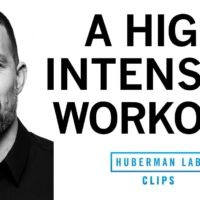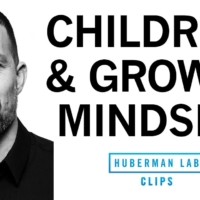How to Maximize Dopamine & Motivation – Andrew Huberman
00:00:08
I think one of the most important findings in the last few years in neuroscience is that while the molecule dopamine is associated with reward it’s more about motivation and craving there’s a really classic experiment now that people use to demonstrate this take two rats
00:00:30
and the rats independently separate cages can lever press for food or when they can access food there’s a little bit of dopamine that’s released anytime they get some food so we always thought that food like many other rewards like food sex warmth when you’re cold cool when you’re too warm
00:00:52
is triggering the release of dopamine but someone had the good idea to deplete dopamine in one of those animals and then what you find is that the animal without dopamine still enjoys food still enjoys other pleasures so dopamine is not really involved in the enjoyment of those pleasures
00:01:11
it’s involved in motivation because if you make the animal have to move just one rat’s length believe it or not to get to that lever the animal with dopamine will work to go get that thing it will work through some effort to go get the reward whereas the animal or turns out the human without
00:01:28
much dopamine can still experience pleasure they can sit on their couch and cram their face with pleasure inducing calories or what have you watch pleasure inducing things on the television but they have very little motivation to go pursue things that will deliver them pleasure
00:01:45
it’s actually what’s really driven the forward evolution of our our species has been the desire to go seek things beyond the confines of our skin and when i say the common currency is dopamine what i mean is the molecule dopamine when secreted in the brain makes us pursue
00:02:00
things build things create things makes us want new things that we don’t currently already have and so it has a lot of dimensions to it but rather than think about dopamine as a signal for reward like a dopamine hit we classically think to talk about it it’s more accurate really to think about
00:02:16
dopamine as driving motivation and craving to go seek rewards that’s the rad experiment and it’s a way of tabulating where we are in our life are we doing well or are we doing poorly and that happens on very short time scales like you wake up feeling good or do you wake up feeling kind of low
00:02:33
or on long time scales if you’re halfway through a long degree or you’re halfway through your life how are you doing how do you gauge that well it has everything to do with how much dopamine you were releasing in the previous days and weeks and years so you’re always comparing and all of this
00:02:48
is subconscious but what’s cool is that once you make these processes conscious once you understand a little bit about how dopamine is released and how it changes our perspective and our behavior then you can actually work with it and so we go back to this example the person that’s
00:03:01
not motivated that can’t get off the couch that doesn’t want to do anything well this is the problem they are effectively the rat with no dopamine but they can still achieve some sense of pleasure by consuming excess calories by consuming social media and look i’m
00:03:16
not judging i do this stuff too right scrolling social media if you’ve ever scrolled social media and you’re like i don’t even know why i’m doing this it doesn’t really feel that good and i can remember a time where you’d see something it was just so cool or you
00:03:30
see something online i remember this when ted talks first came out i was like this is amazing these are some at least some of them are really smart people sharing really cool insights and then now that they’re like a gazillion ted talks i remember spending a winter in my office at
00:03:43
when i was a junior professor cleaning my office finally and binging ted talks in the background thinking this is a good use of my time pretty soon they all sucked to me i was like this isn’t good so what you need to do is stop watching dead docs for a while wait and then they become interesting
00:03:58
again and that’s this pain pleasure balance and so for people that aren’t feeling motivated the problem is they’re not motivated but they’re getting just enough or excess sustenance so they’re getting the little mild hits of opioid it becomes an opioid system and if you think
00:04:13
about the opioid drugs as opposed to dopamine dopaminergic drugs dopaminergic drugs make people rabid for everything you know drugs of abuse like cocaine amphetamine make people incredibly outward directed or they hardly notice anything except what they want more of one more more it’s
00:04:28
very it’s bad because those drugs trigger so much dopamine release that they become the reward it’s very circular the only the drug can give that much dopamine nothing they could pursue would give them as much dopamine as the drug itself so there’s that and then there’s the kind of opioid
00:04:45
like effects of constantly indulging oneself with social media or with video games or with with food or with anything to the point where it no longer evokes the motivation and craving and this is really the new evolution of the understanding of dopamine in neuro in neuroscience
00:05:01
which is that dopamine itself is not the reward it’s the build up to the reward and the reward has more of a kind of opioid bliss-like property which itself is not bad if it’s endogenous released from within but when we can just sit there like the like the rat with no dopamine gorging
00:05:18
ourselves with pleasures so to speak what you end up with is somebody that feels really unmotivated and those pleasures no longer work to tickle those feel good circuits and so there’s no reason for them to go out and pursue anything the problem is not pleasures the problem is that
00:05:35
pleasure experienced without prior requirement for pursuit is terrible for us it’s terrible for us as individuals it’s terrible for us as as groups and i have great confidence in the human species to work this out but we are finding now and we are going to increasingly find
00:05:53
that those who will be successful young or old are going to be those people who can create their own internal buffers they’re going to be able to control their relationship to pleasures because the proximity to pleasures and the availability is the problem if you look at the increase in
00:06:09
use of drugs of abuse or prescription medication which at least at the first past deliver pleasure pain relief the whole issue with the opioid crisis and dopaminergic drugs like ritalin adderall you know there is sometimes there’s a clinical need but tons of people are taking those recreationally
00:06:25
now or to study huge dopamine increases are what those cause that is a problem that’s a serious problem because it creates a cycle where you you need more of that specific thing i always say addiction is a progressive narrowing of the things that bring you pleasure god that’s
00:06:42
such a good difference and you know and i don’t like to comment too much on enlightenment because you know i don’t really know what that is as a neurobiologist but a good life we could say is a progressive expansion of the things that bring you pleasure and even better is a good life is a
00:06:54
progressive expansion of the things that bring you pleasure and includes pleasure through motivation and hard work and understanding this pain pleasure balance whereby if you experience pain and you can continue to be in that friction and exert effort the rewards are that much greater when they arrive
00:07:11
and so i think that if you look at any drug of abuse or any situation where somebody isn’t motivated or thinks that now they may have clinically diagnosed attention deficit hyperactivity disorder but a lot of what people think is adhd it turns out is people just over
00:07:26
consuming dopamine from various sources and then and also the context within a tick-tock feed is the context switch is insane the brain has never seen first of all there’s the first time in human evolution that we wrote with our thumbs but that’s a pretty benign shift and that the other shift is
00:07:42
normally you walk from one room to another or from a field into the trees or from a hut into or a house or whatever it is but now you can get 10 000 context switches in that 30 minutes of scrolling on instagram or to talk and so it’s all about self-regulation we are going to select for the
00:07:57
people that can self-regulate and so then people say well how do you self-regulate how do kids self-regulate well this is my hope and one of the reasons i’ve gotten excited about public education and teaching neuroscience is that this is a place where knowledge of knowledge actually can allow
00:08:12
oneself to intervene when you think i’m feeling low i don’t feel good nothing really feels like am i depressed maybe but maybe you’re just you’ve saturated the dopamine circuits you’re now in the pain part of things what do you do well you have to stop you need you need to replenish dopamine
00:08:29
you need to stop engaging with this behavior and then your pleasure for it will come back but you have to constantly control the hinge it’s not just about being back and forth on the seesaw you have to make sure the hinge doesn’t get stuck in pain or in pleasure understanding that pain
00:08:43
and pleasure in this really dynamic balance can also help us which in the following way any pain that you feel the longer day the less sleep the the kind of agony that things aren’t working that power outlet doesn’t work or the internet is slow whatever it is
00:08:59
the amount of pleasure that you will eventually experience is directly relation related excuse me to how much pain you experience so we know this from actually what nowadays would be considered quite barbaric and unethical experiments where they would give people electrical shocks
00:09:14
and they would measure their response and then they’d say we’re going to increase it we’re going to increase it eventually they get to the point where a slight uh shock that was previously very painful actually evokes a sense of pleasure now you couldn’t do these experiments anymore
00:09:29
these are not the experiments i do in my lab and these are older experiments but for instance i and this has been discussed in scientific research papers uh giving somebody a like a ten minute ice bath for instance or even a three-minute ice bath or a one-minute ice bath it’s quite painful but
00:09:44
there was a study from the university of prague uh european journal physiology showed that after a painful ice bath stimulus the amount of dopamine release goes up for two and a half hours to 250 percent above baseline and that’s not because the ice bath itself evokes dopamine
00:10:02
release a lot of people think oh cold water of ox dopamine release no pain evokes dopamine release after the pain is over just understanding the more friction and pain that you experience the greater the dopamine reward you will get later and that serves as its own amplifier of the whole process
00:10:18
of pursuing more dopamine so the the keys are to pursue rewards but understand that the pursuit is actually the reward if you want to have repeated wins then what you realize is your capacity to tap into dopamine as a motivator not just seeking dopamine rewards that is infinite













